FDPIR Food Package Enhancements: Add More Protein, Fruit, and Vegetable Options
Recent updates to the FDPIR food package were made in a collaborative effort to align the food package with the Dietary Guidelines for Americans and support nutrition equity in FDPIR. As of September 1, 2023, more protein, fruit, and vegetable options are available to FDPIR customers. The recent food package enhancements are below:
- Egg units increased from 1 to 2 units.
- Vegetable units increased from 13 to 18 units.
- Meat/poultry/fish units increased from 3 to 5 units.
- Bison stew meat, frozen in a 2 lb. pack and strawberries, frozen in a 1 lb. pack.

Recipe Corner: How Do I Use the New Foods in the FDPIR Food Package?
Frozen bison stew meat in a two-pound package and frozen strawberries in a one-pound pack have been added to the food package. Have you tried them yet? Here are some things to consider when taking home these new foods:
Bison is a traditional food to many Native American communities across North America. It is a good source of lean protein, which provides the building blocks for healthy bones, muscles, skin, and blood. Frozen bison should be kept frozen until ready to thaw and use. Thaw in the refrigerator overnight or use the defrost setting in the microwave.
-
Use a slow cooker or braising pan in the oven to cook bison stew meat low and slow.
-
Bison stew meat goes well with added liquid and vegetables. Try braising in stock and adding vegetables such as carrots, potatoes, and cabbage.
-
Pair your favorite bison stew recipe with prepared rice, finely chopped and sautéed cauliflower, or cornbread.
Strawberries are a nutrition powerhouse, full of fiber, vitamins C and A, iron, and folic acid. They provide natural sweetness and color to smoothies, sauces, and jams, or as a topping on yogurt or oatmeal. Frozen strawberries should be kept in the freezer at or below 0°F until ready to use. Thaw according to package instructions or use them frozen.
Storage and Preparation Tips!
-
Did you know? Frozen strawberries are individually quick frozen so you can open the bag, take what you need, and put the rest back in the freezer. You may need to use your hands to break frozen strawberries apart when taking out the amount needed.
-
Add frozen strawberries to baked items such as breads and muffins, or to smoothies.
|
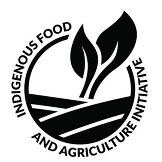
Produce Training in Development
In September, FNS awarded a cooperative agreement to the Indigenous Food and Agriculture Initiative at the University of Arkansas (IFAI) to develop a FDPIR Produce Training. The training will provide hands-on learning opportunities for FDPIR program operators to support staff receiving produce through the USDA Department of Defense Fresh Fruit and Vegetable Program (DoD Fresh). The training will help programs assess and safely distribute fresh produce to program participants while improving overall customer satisfaction. We will share more information regarding the FPDIR Produce Training in future FDPIR e-letters!
|
Closing Out FY23 With 52 Community Nutrition Champions Trained!
By Tiffany Grant, Oklahoma Tribal Engagement Partners (OKTEP)
Greetings from Indian Country! As FY23 came to a close, we finished year one of Community Nutrition Champion Training (CNCT) in the Pacific Northwest and Alaska, with a stop in Kansas City to see some old friends.
In July, we headed to Bellingham, Washington, where we trained 12 Champions from 12 tribal nations throughout the Northwest Region.
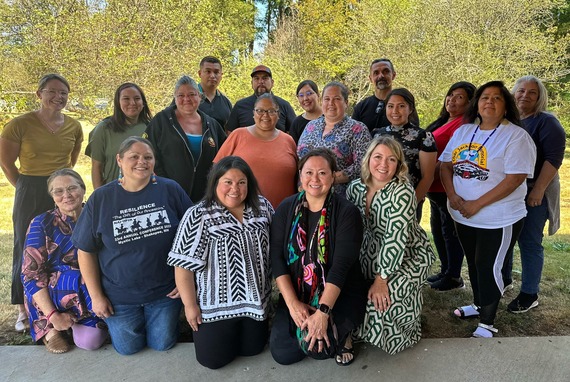 In August, we headed to NAFDPIR in Kansas City. What fun it was to reconnect with so many Champions! It was great to catch up and hear what wonderful things they are doing since attending CNCT.
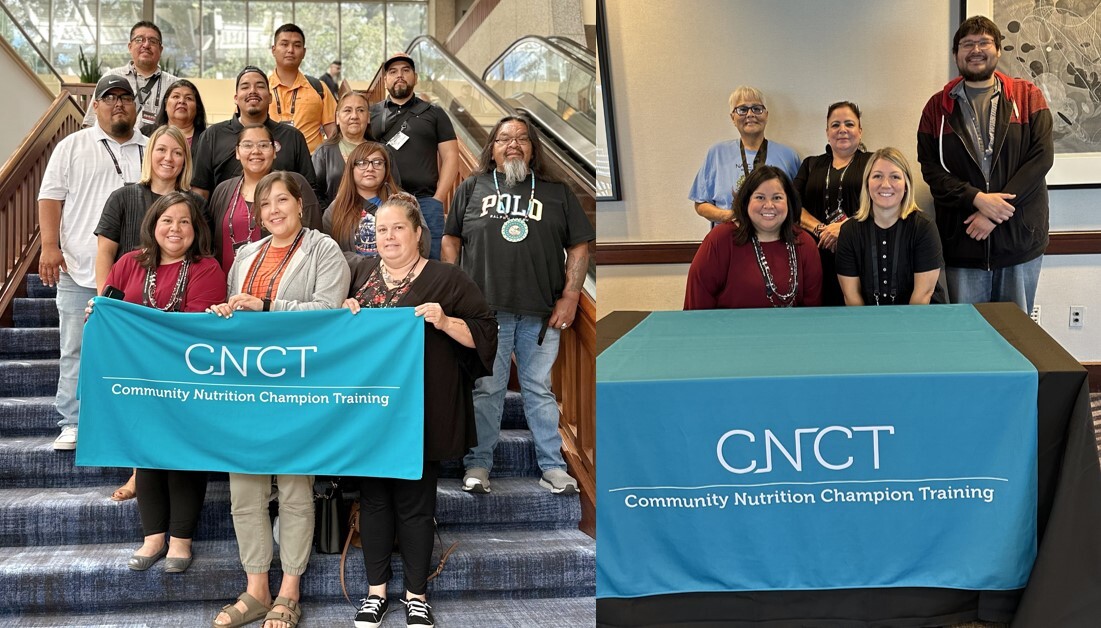 We then headed north to Alaska! In September, we traveled to Anchorage to meet with the Alaska Native Tribal Health Consortium (ANTHC) and trained seven Champions from seven tribal villages and two Champions from ANTHC.
CNCT is all about community nutrition and the Champions we meet. We have enjoyed connecting with and learning from each of our 52 Champions over the last year. Hear what some of our Champions had to say about CNCT:
“The training was very good. Opened my eyes to new ways on how to conduct a cooking demonstration. Gave me some very good tips on speaking in front of people. Reminded me that it is ok to make a mistake, it can be fixed. The ladies were very encouraging through the whole training, It is good to have people like that to be involved. I like how we had group activities. That way it is a learning experiences for everyone involved and you are learning together.” -- Albuquerque Champion
“The training was more than I hoped for and would really like to continue on learning. It gave another view point on how to do food demos.” -- Grand Rapids Champion
“Very important information to learn and share; keep up the great attitude, the training is awesome.” -- Rapid City Champion
“Thank you for everything. I feel confident in being able to infuse this knowledge with my position.” -- Bellingham Champion
Want to connect with us for our FY24 trainings?
Click the button below to learn more:
We are very excited for the year ahead and look forward to meeting even more Champions in FY24!
FDA’s Center for Food Safety and Applied Nutrition Invites Tribes to Call on October 24th about Nutrition Initiatives
The U.S. Food and Drug Administration (FDA) invites federally recognized American Indian and Alaska Native Tribes to participate in an all tribes call with the FDA’s Center for Food Safety and Applied Nutrition (CFSAN) to learn about FDA’s nutrition initiatives. FDA is prioritizing its nutrition initiatives to ensure people in the United States have greater access to healthier foods and nutrition information we can all use to identify healthier choices more easily.
CFSAN will host the all tribes call to share an overview of its nutrition initiatives and receive tribal feedback, including tribes’ experiences with food labels, accessing healthy foods, and using nutrition information. The call will be held on October 24, 2023, 4:00-5:00pm ET. To participate, you must register by clicking the button below.
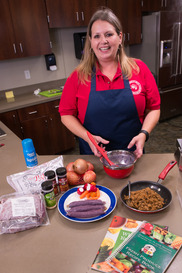
Four Ways Tribes are Using their Nutrition Education Funding!
FDPIR administering tribes and organizations have submitted plans for how they will use the $4 million in FDPIR nutrition education funds in FY 2024. Are you wondering what other FDPIR programs are planning to do with their nutrition education funds? Take a look at some of the ideas below and start the conversation about how you can bring activities like these to your community!
-
Hire a project coordinator and a graphic designer to assist with projects and updating media with new nutrition education such as recipes, cooking videos, informational flyers, and coordinating nutritional outreach events.
-
Develop a raised bed herb garden adjacent to the store to conduct nutrition education on a variety of topics such as using herbs in place of salt.
-
Implement quarterly or monthly in-person or virtual events where participants can earn a Nutrition Education certificate and become Nutrition Education Leaders in their community. Nutrition Education Leaders can teach and facilitate in-person food demos and virtual webinars to hold each other accountable to improve health and quality of life. .
-
Incorporate tribal wellness practices, create wellness policies, and incorporate prompts at community gatherings, and celebrations that reinforce one or more nutrition-related outcomes, including incorporating traditional food sources harvested locally.
|
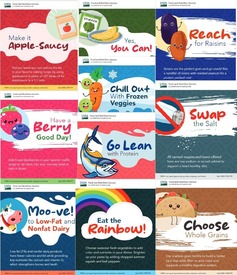
Free Resources Available in the USDA Foods Nutrition Education Resource Library
What is available now? How do I use it?
Posters: Brighten the walls of your warehouse, inside the tailgate, or grocery store with these posters.
Recipe Cards: Need a recipe for an FDPIR food? These colorful recipe cards come in a pack of 10 and often highlight traditional foods available in FDPIR.
Shelf Talkers: Informative and fun, display these small signs next to items around your store. Each shelf talker promotes following a balanced diet with FDPIR foods, such as eating whole grains, choosing colorful fruits and vegetables, cutting back on salt, and much more!
Stickers: Are you “Nuts about Nutrition,” or want to encourage your kids to “Eat the Rainbow?” These stickers are a great way to engage young children in nutrition education.
Brochure: Community members may need more information about FDPIR. Use this tri-fold brochure to provide details about what is offered in the FDPIR food package, eligibility, and how to enroll.
Please note that resources cannot be shipped to a P.O. Box and will take 2 – 3 weeks for delivery. If you have any questions, please contact us at USDAFoods@usda.gov.
|
FY 2024 FDPIR Income Standards (Exhibit M)
At the beginning of each Federal fiscal year, FNS posts the updated net monthly income standards (Exhibit M) for FDPIR. These income standards were effective starting October 1, 2023.
The net monthly income standard for each household size is the sum of the applicable Supplemental Nutrition Assistance Program (SNAP) net monthly income standard and the applicable SNAP standard deduction. Exhibit M of the FNS Handbook 501 also includes allowable income deductions for earned income, dependent care, child support, medical expenses, home care meals, and shelter/utility standard deduction by Region.
The FY 2024 net monthly income standards were disseminated by the FNS Regional Offices in September, and are available on the FNS Handbook 501 page. Please reach out to your FNS Regional Office with any questions.
FDPIR Self-Determination Project Continues to Empower Tribal Nations
In August 2023, USDA’s Food and Nutrition Service signed contracts with eight additional Tribes to operate Food Distribution on Indian Reservations (FDPIR) Self-Determination Demonstration Projects. Through these projects, Tribal Organizations administering FDPIR enter into self-determination contracts with USDA to select and purchase foods for the FDPIR food packages distributed to their Tribal members. Empowering Tribal nations to select and purchase their own foods helps better align FDPIR food packages with Tribal dietary preferences, supports indigenous agriculture producers, and honors Tribal sovereignty.
The Tribes that have been recently awarded contracts are listed below:
- Cherokee Nation
- Confederated Tribes of the Umatilla Indian Reservation
- Gila River Indian Community
- Quinault Indian Nation
- Sokaogon Chippewa Community
- Spirit Lake Tribe
- Tohono O’odham Nation
- White Mountain Apache Tribe
With these additional contract awards, 16 Tribal Organizations are now participating in the FDPIR Self-Determination Demonstration Project and collectively overseeing $10 million in FDPIR self-determination contract funds. The eight new tribes are procuring a wide variety of fresh local produce, meats, dairy products, and grains to meet the unique dietary needs of their communities. With their recently awarded contract, the White Mountain Apache Tribe plans to procure locally produced patty pan squash, green chiles, blue cornmeal, beef intestines, pine nuts/pinions, and more. You can find more details about each Tribe’s project on the FNS website.
This map highlights tribes currently participating in the demonstration project.
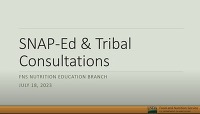
SNAP-Ed and Tribal Consultations Webinar
On July 18, 2023, the FNS Nutrition Education Branch (NEB) and the Tribal Affairs Specialists hosted a webinar to discuss SNAP-Ed and Tribal Consultations. Topics include SNAP Tribal Consultations and intersectional opportunities for both Tribes and SNAP-Ed to explore nutrition education.
|
Limited Releases in WBSCM in Coming Months
Due to an ongoing, large-scale data migration project, WBSCM has entered a “brownout” period as of August 1, 2023. During the brownout, WBSCM releases will be minimal, limited to routine maintenance and critical bug fixes. The WBSCM support team expects that this period will last at least 6 months and may be extended depending on the resources required to complete the data migration project. The USDA Foods Technology Branch will provide schedule updates as available.
WBSCM User Feedback Sessions
FNS has begun hosting monthly WBSCM user feedback sessions for State agency and Indian Tribal Organization (ITO) users. Recipients and local agencies are also invited to attend. These sessions are an opportunity to identify challenges and opportunities for potential enhancements and future training in WBSCM. The meetings are held on the second Tuesday of each month; the next meeting is scheduled for Tuesday, November 14, 2023, at 3 PM ET. If you are interested in participating in future sessions, please contact Samantha Escamilla.
|